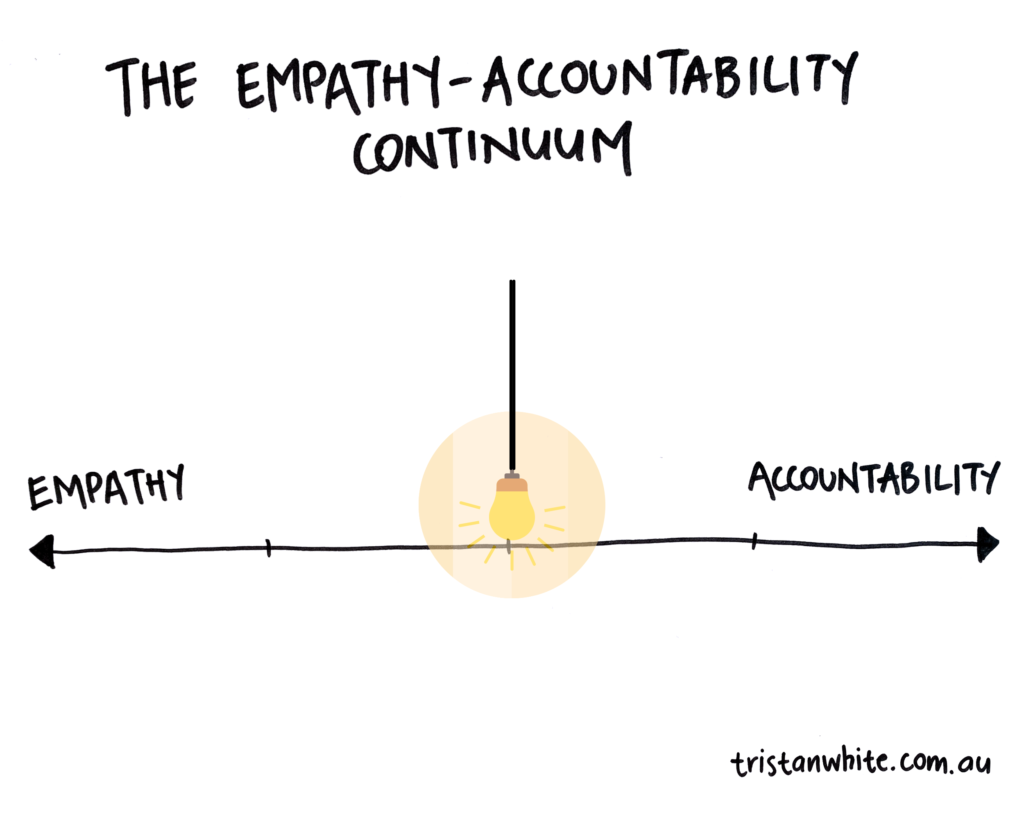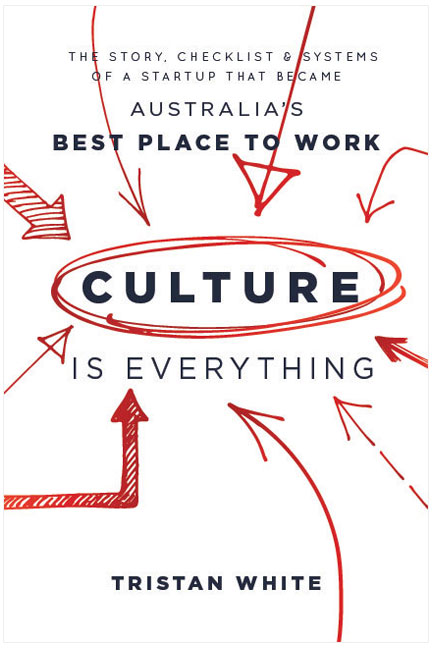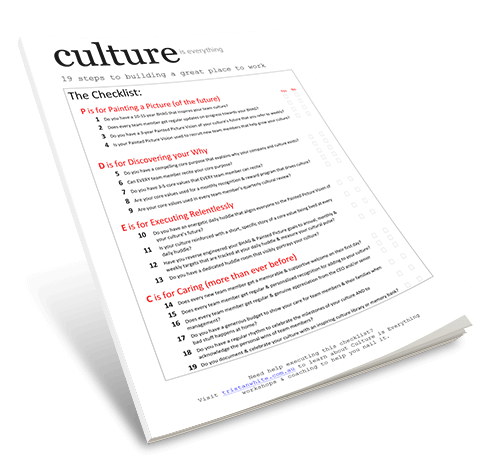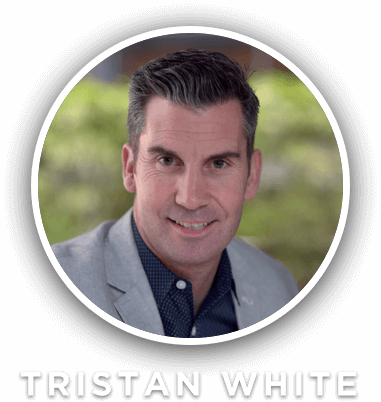
As leaders, we hear over and over that understanding how to use empathy is super-important.
At the same time, we have ever-increasing workloads and the demands of our jobs seem to get more and more (let alone keeping up with the shifting sands of COVID-19).
For me, and plenty of the leaders I work with in the Culture Is Everything Club, there seems to be an ever-present tension between when to use empathy and when to flex our assertiveness muscles to ensure accountability.
So, how do we blend empathy with a leadership style that holds others to account in an inspiring and sustainable way?
I’ve devised what I call the ‘Empathy-Accountability Continuum’ to explain how we can master this complex challenge – and I think it could be super-helpful for you, your team and your relationships - at work and at home.
Introducing the Empathy-Accountability Continuum
The Empathy-Accountability Continuum embraces the ‘genius of the AND’ concept created by Jim Collins. That is, we don't have to choose empathy OR accountability. We choose BOTH.
For example, in a conversation with a teammate, your best approach might be a little empathy AND plenty of assertiveness to ensure accountability.
In a different conversation, more empathy and less accountability could be the best blend for your working relationship in the short and long term.
A visual picture of the Empathy-Accountability Continuum
To get an idea of what I’m talking about, imagine you’re sitting at a desk in a dark room with a piece of plain white A4 paper in front of you.
That piece of paper is in landscape orientation with a straight, bold line drawn from one end to the other. At the left end of the line, the word EMPATHY is written in thick, black ink.
At the right end of the line, all the way at the other end of the sheet of paper, the word ACCOUNTABILITY is written in thick, black ink.
Between the two words, there are a few small marks or increments drawn on the line.
This is how the Empathy-Accountability Continuum looks on paper.

How the Empathy-Accountability Continuum works in real life
In practice, it’s more like this...
If I was in a conversation with a member of my team, and my focus was 100% on connecting with empathy and 0% on the work that needed to be done, I’d be acting at the extreme empathy end of the continuum.
In another conversation, I might be 100% focused on a work deadline and 0% focused on anything to do with the other person’s needs, wants, feelings or preferences. Then I’d be acting at the extreme accountability end of the continuum.
The reality is that I’m rarely at either extreme end of this continuum and I doubt you are, either.
The solution: a blend of empathy AND accountability
This is the Empathy-Accountability Continuum and we leaders need to get the hang of using an ever-changing blend of both empathy and accountability if we’re going to connect in a meaningful, human way with our teammates AND make them accountable for the work that needs to be done.
Now, that’s the theory, but here’s where it gets more interesting and the reason that understanding this and then mastering it is so difficult.
Discovering my empathy-accountability blind spot
For most of the 17 years I’ve been running a business and leading a team, I was only really using one half of the Empathy-Accountability Continuum.
By default, I’m more naturally a people and empathy-oriented leader (even before the word ‘empathy’ became so popular!). Because of my blind spot to the accountability side of the continuum, I was only able to see and choose to act from the extreme empathy end of the continuum to somewhere near the middle.

A few years ago, I realised that I’d never become the leader I wanted to be if I didn’t get better at holding people to account on the work that needed to be done.
Up until then, if a team member wasn’t getting the work done and I would meet them weekly to try to improve their performance, I’d end the conversation (even after something like a dozen consecutive meetings), with something like, “Do your best and I’ll be here next Monday if it doesn’t work out”.
That approach didn’t work. It almost never will. It was useless.
But that was the only way I knew, because I had no idea how to be a considerate leader AND hold others to what they said they’d do.
Deciding to own my discomfort
Over the following 12-18 months, after realising what needed to improve for me to become a better leader, I worked closely with an executive coach, Anita, to learn how to communicate more assertively and hold others to account in a way that worked for everyone.
That self-awareness and communication work I did with Anita’s guidance was some of the most difficult personal development I’ve ever done.
Pushing myself through my own discomfort could be excruciating. But it was worth it because the communication skills that had got me to that point weren’t going to be enough to get me to where I wanted to go. I knew I had to push on.
During that intense time of working on myself, it was like someone had shone a light on the A4 piece of paper on my desk in that dark room and said: “Look over to the right of the straight, bold line, there’s so much more you could be doing to get more accountability.”
The result of that work I did with Anita is that I now have much more awareness and skill in choosing the blend of empathy and accountability I need to use in every conversation to be the connected leader who gets important work done with their team.
Some other empathy-accountability blind spots
You may resonate with a similar situation to mine, where you need to shine a light on the accountability side of the continuum – or other variations.
It’s possible that your style is more on the right side of this empathy-accountability continuum, and most of your focus is therefore on accountability, with less time spent knowing when to connect with empathy.
If that’s the case, you’ve got important work to do that will see you become a more people-focused leader who can unearth the empathy needed to get important work done by more inspired teammates.
Lastly, you might be aware and able to access both empathy and accountability at different times, but you might be hanging out mostly in the middle of the continuum and need a gentle prod to explore the extremes.
If that’s you, then picture that A4 piece of paper with both ends now in the spotlight, meaning even more empathy and accountability for you to use.
So that’s it. The Empathy-Accountability Continuum.
The two critical parts of success with this model are:
- Awareness of where we are on the continuum and what’s needed, in the moment; and,
- Strong and personal and professional relationships with the people in our team (you can learn more about it here).
Dig into this TODAY!
I urge you to dive into understanding the Empathy-Accountability Continuum, because it’s super-important for leaders. It’s been a critical factor in my success, not just as a leader of people, but also as a CEO of a fast-growing and profitable company.
Mastering this skill could save hours of your time by better connecting with teammates, or help you to avoid the overwhelming worry that can affect us leaders when we can’t figure out how to discuss sensitive topics or pass on important feedback.
Please find 10 minutes TODAY to listen to the short, 10-minute episode 82 of the Think Big Act Small podcast.
You can listen on Apple Podcasts, Spotify or wherever you get your podcasts from.



